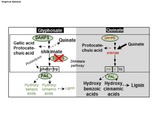Mostrar el registro sencillo del ítem
The pattern of shikimate pathway and phenylpropanoids after inhibition by glyphosate or quinate feeding in pea roots
| dc.creator | Zabalza Aznárez, Ana | es_ES |
| dc.creator | Orcaray Echeverría, Luis | es_ES |
| dc.creator | Fernández Escalada, Manuel | es_ES |
| dc.creator | Zulet González, Ainhoa | es_ES |
| dc.creator | Royuela Hernando, Mercedes | es_ES |
| dc.date.accessioned | 2017-09-13T07:28:58Z | |
| dc.date.available | 2018-09-01T23:00:12Z | |
| dc.date.issued | 2017 | |
| dc.identifier.issn | 0048-3575 (Print) | |
| dc.identifier.issn | 1095-9939 (Electronic) | |
| dc.identifier.uri | https://hdl.handle.net/2454/25560 | |
| dc.description.abstract | The shikimate pathway is a metabolic route for the biosynthesis of aromatic amino acids (AAAs) (i.e. phenylalanine, tyrosine, and tryptophan). A key enzyme of shikimate pathway (5-enolpyruvylshikimate-3-phosphate synthase, EPSPS) is the target of the widely used herbicide glyphosate. Quinate is a compound synthesized in plants through a side branch of the shikimate pathway. Glyphosate provokes quinate accumulation and exogenous quinate application to plants shows a potential role of quinate in the toxicity of the herbicide glyphosate. Based on this, we hypothesized that the role of quinate accumulation in the toxicity of the glyphosate would be mediated by a deregulation of the shikimate pathway. In this study the effect of the glyphosate and of the exogenous quinate was evaluated in roots of pea plants by analyzing the time course of a full metabolic map of several metabolites of shikimate and phenylpropanoid pathways. Glyphosate application induced an increase of the 3-deoxy-D-arabino-heptulosonate-7-phosphate synthase (DAHPS, first enzyme of the shikimate pathway) protein and accumulation of metabolites upstream of the enzyme EPSPS. No common effects on the metabolites and regulation of shikimate pathway were detected between quinate and glyphosate treatments, supporting that the importance of quinate in the mode of action of glyphosate is not mediated by a common alteration of the regulation of the shikimate pathway. Contrary to glyphosate, the exogenous quinate supplied was probably incorporated into the main trunk from the branch pathway and accumulated in the final products, such as lignin, concomitant with a decrease in the amount of DAHPS protein. | en |
| dc.description.sponsorship | This work was financially supported by a grant from the Ministerio Español de Economía y Competitividad (AGL-2013-40567R). L.O. received a grant from the Ministerio de Educación. M. F-E and AZ-G received funding from fellowships from Universidad Pública de Navarra. | en |
| dc.format.mimetype | application/pdf | en |
| dc.language.iso | eng | en |
| dc.publisher | Elsevier | en |
| dc.relation.ispartof | Pesticide Biochemistry and Physiology 141 (2017) 96–102 | en |
| dc.rights | © 2016 Elsevier Inc. The manuscript version is made available under the CC BY-NC-ND 4.0 license. | en |
| dc.rights.uri | https://creativecommons.org/licenses/by-nc-nd/4.0/ | |
| dc.subject | Aromatic amino acids | en |
| dc.subject | DAHPS | en |
| dc.subject | EPSPS | en |
| dc.subject | Phenylpropanoid metabolism | en |
| dc.subject | Hydroxybenzoic acids | en |
| dc.subject | Hydroxycinnamic acids | en |
| dc.title | The pattern of shikimate pathway and phenylpropanoids after inhibition by glyphosate or quinate feeding in pea roots | en |
| dc.type | Artículo / Artikulua | es |
| dc.type | info:eu-repo/semantics/article | en |
| dc.contributor.department | Ciencias del Medio Natural | es_ES |
| dc.contributor.department | Natura Ingurunearen Zientziak | eu |
| dc.rights.accessRights | Acceso abierto / Sarbide irekia | es |
| dc.rights.accessRights | info:eu-repo/semantics/openAccess | en |
| dc.embargo.terms | 2018-09-01 | |
| dc.identifier.doi | 10.1016/j.pestbp.2016.12.005 | |
| dc.relation.projectID | info:eu-repo/grantAgreement/MINECO//AGL2013-40567-R/ES/ | en |
| dc.relation.publisherversion | https://doi.org/10.1016/j.pestbp.2016.12.005 | |
| dc.relation.publisherversion | https://dx.doi.org/10.1016/j.plantsci.2017.08.003 | |
| dc.type.version | Versión aceptada / Onetsi den bertsioa | es |
| dc.type.version | info:eu-repo/semantics/acceptedVersion | en |
| dc.contributor.funder | Universidad Pública de Navarra / Nafarroako Unibertsitate Publikoa | es |



